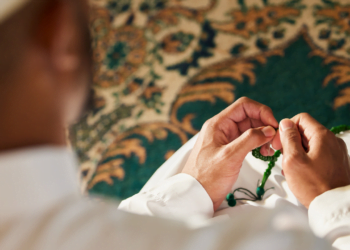No products in the cart.
How to Discover Traditional Prayers
This post contains paid and/or affiliate links. I make a small commission at no extra cost to you. Please see our Privacy Policy.
Traditional prayers hold a significant place in many cultures and religions worldwide. Learning these ancient prayers can provide a deep spiritual connection and an understanding of cultural heritage.
If you are wondering where you can learn traditional prayers, there are various avenues you can explore to deepen your knowledge and practice.
Places of Worship:
One of the most traditional and authentic ways to learn traditional prayers is by visiting places of worship such as churches, temples, synagogues, mosques, or any other religious institution. These sacred spaces often offer prayer services, classes, or study groups where you can learn from experienced practitioners and religious leaders.
Community Events:
Many communities host events or gatherings centered around traditional prayers and spiritual practices. These events can include prayer circles, chanting sessions, or workshops on teaching traditional prayers. Participating in these activities can help you learn from others and foster a sense of community.
Online Resources:
In today’s digital age, many online resources are available for those looking to learn traditional prayers. Websites, forums, and online courses dedicated to traditional prayer practices can provide valuable information, tutorials, and even virtual prayer groups for individuals seeking to deepen their understanding.
Books and Literature:
Another excellent way to learn traditional prayers is through books, scriptures, and religious texts. Many religious traditions have sacred texts that contain prayers and rituals passed down through generations. By studying these texts, you can gain insights into the meaning and significance of traditional prayers.
Personal Guidance:
Seeking a mentor, spiritual advisor, or elder within your community can also be a valuable way to learn traditional prayers. These individuals often have a wealth of knowledge and experience that they are willing to share with those eager to learn and grow in their spiritual practice.
Learning traditional prayers is a personal and enriching journey that can deepen your spiritual connection and cultural understanding. By exploring various avenues, such as places of worship, community events, online resources, books, and personal guidance, you can embark on a transformative path toward incorporating traditional prayers into your daily life.
Preserving Traditional Prayer Practices: A Timeless Reverence
Acknowledging and upholding the significance of preserving traditional prayer practices as they hold a deep-rooted cultural and spiritual value. Traditional prayers have been passed down through generations, weaving a tapestry of devotion, faith, and heritage that transcends time and connects individuals to their roots. These prayers serve as a beacon of guidance, offering solace, strength, and a sense of belonging to those who recite them.
Preserving traditional prayer practices goes beyond mere repetition of words; it encompasses a profound understanding of each prayer’s rituals, meanings, and intentions. By immersing oneself in these prayers’ rich history and traditions, individuals can cultivate a deeper spiritual connection and foster a reverence for the practices that have sustained communities for centuries.
Furthermore, preserving traditional prayer practices is a form of cultural conservation, safeguarding invaluable customs and beliefs from being lost to the sands of time. These prayers embody past generations’ collective wisdom, experiences, and aspirations, offering a glimpse into the struggles, triumphs, and values that have shaped societies throughout history.
Preserving traditional prayer practices becomes crucial in a rapidly changing world where modernity often eclipses tradition. Individuals preserve their cultural identity by honoring and upholding these practices, fostering a sense of continuity and belonging that transcends borders and generations.
Essentially, the significance of preserving traditional prayer practices lies in its ability to transcend time, weave communities together, and provide individuals with a timeless connection to their heritage. These prayers are not just words spoken in reverence; they are sacred threads that bind individuals to the past, present, and future, offering a sanctuary of solace, faith, and unity in an ever-evolving world.
Online Resources for Studying Traditional Prayers
Are you looking to delve into the profound world of traditional prayers and enrich your spiritual practice? Discovering the beauty and depth of traditional prayers can be a transformative journey, leading to inner peace and spiritual growth. Luckily, in today’s digital age, many online resources are available to help you learn and understand traditional prayers from various cultures and religions.
One of the first places to explore when seeking to learn traditional prayers online is through religious or cultural websites. Many religious organizations and communities offer resources, such as prayer books, instructional videos, and recorded chants or hymns, that can guide you through the practice of traditional prayers. These resources often provide historical context and explanations behind the prayers, allowing for a deeper understanding of their significance.
Additionally, online courses and webinars focused on traditional prayers can be valuable tools for those seeking a more structured and in-depth learning experience. Platforms like Coursera, Udemy, and even YouTube offer courses led by religious studies and spirituality experts. These courses teach traditional prayers’ words and meanings and explore their cultural and theological roots.
For individuals who prefer a more interactive approach to learning, online forums and discussion groups provide opportunities to engage with like-minded individuals who are also exploring traditional prayers. These online communities can offer support, guidance, and a sense of camaraderie as you navigate your journey into the realm of traditional prayers.
Furthermore, some virtual libraries and databases house a wealth of information on traditional prayers from various faith traditions. Websites like Sacred Texts, Internet Sacred Text Archive, and Project Gutenberg offer free access to various religious texts, including prayer books, scriptures, and historical manuscripts. These resources can serve as invaluable references as you study and immerse yourself in traditional prayers.
The internet has revolutionized how we access and engage with traditional prayers, making learning and appreciating these sacred practices easier. By taking advantage of online resources, you can deepen your spiritual connection, broaden your knowledge of different religious traditions, and find solace and inspiration in the timeless words of traditional prayers. Embark on this virtual journey of discovery and let the wisdom of traditional prayers enrich your mind, body, and soul.
Ways to Embrace Traditional Prayers in Your Daily Routine
Traditional prayers are sacred in many cultures and religions, offering a way to connect with the divine and cultivate a sense of peace and gratitude in daily life. Here are some practical steps to infuse traditional prayers into your everyday routine:
One of the simplest ways to start incorporating traditional prayers into your daily life is by setting aside a specific time each day for prayer and reflection. Whether upon waking up in the morning, before meals, or before bed, establishing a regular prayer schedule can help create a sense of consistency and mindfulness throughout your day.
Another way to integrate traditional prayers into your daily routine is by creating a sacred space within your home to pray and meditate. This can be a designated corner with a small altar, candles, religious symbols, or meaningful objects that help create a peaceful and spiritual atmosphere conducive to prayer.
In addition to personal prayer practices, participating in traditional prayer services at a local place of worship or community center can be a powerful way to deepen your connection to traditional prayers. Attending religious services allows you to engage with others in prayer, share in collective worship, and strengthen your sense of community and belonging.
Exploring traditional prayer rituals and practices specific to your cultural or religious background can enrich your daily spiritual life. Whether reciting specific prayers, performing rituals, or observing significant holy days, immersing yourself in age-old traditions can deepen your understanding and appreciation of your faith.
Furthermore, incorporating traditional prayers into your daily routine can profoundly impact your mental, emotional, and spiritual well-being. Studies have shown that regular prayer practices can reduce stress, promote peace and connectedness, and improve overall psychological resilience.
By weaving traditional prayers into your daily life, you honor ancient spiritual traditions and nurture a deeper sense of inner peace, gratitude, and connection to something greater than yourself. Whether through personal prayer, communal worship, or sacred rituals, embracing traditional prayers can be a transformative and enriching journey toward spiritual growth and fulfillment.
Connecting with Community Through Traditional Prayer Gatherings
Traditional prayer gatherings offer a unique opportunity to connect with like-minded individuals who share the same spiritual beliefs and values. These gatherings are a powerful platform for fostering a sense of unity and community among participants.
In a world that often feels increasingly disconnected, traditional prayer gatherings allow individuals to seek solace, support, and guidance through shared traditional practices.
One of the primary benefits of participating in traditional prayer gatherings is the sense of belonging and community it cultivates. Through collective prayer sessions, individuals can feel a deep connection with others who share their faith and values. This communal experience strengthens personal beliefs and reinforces the notion of mutual respect and understanding within the group.
Additionally, traditional prayer gatherings often serve as a platform for individuals to form lasting friendships and bonds with others on a similar spiritual journey.
Furthermore, traditional prayer gatherings offer a unique opportunity for individuals to deepen their understanding of traditional prayers and rituals. Participating in group prayer sessions allows individuals to learn from each other, share insights, and gain a deeper appreciation for the traditional practices integral to their faith.
These gatherings provide a supportive environment where individuals can ask questions, seek guidance, and receive mentorship from more experienced community members.
Participating in traditional prayer gatherings also allows individuals to experience the transformative power of collective worship. The shared energy and devotion permeating these gatherings create a profound spiritual connection and upliftment. By praying together, individuals can experience a heightened sense of peace, gratitude, and inner fulfillment. This shared experience of spiritual elevation can profoundly impact individuals’ emotional well-being and overall outlook on life.
Traditional prayer gatherings play a crucial role in fostering a sense of community, deepening spiritual understanding, and experiencing the transformative power of collective worship. By actively participating in these gatherings, individuals can strengthen their connection to their faith, build meaningful relationships with like-minded individuals, and experience a profound sense of spiritual growth and fulfillment.
Conclusion
Traditional prayers in daily life are a practice that not only nourishes the soul but also connects us to our roots. By setting aside time each day to engage in traditional prayers, whether recitations, hymns, or silent contemplation, individuals can experience a sense of peace, grounding, and spiritual fulfillment.
These prayers provide comfort in times of difficulty, guidance in moments of confusion, and gratitude in periods of abundance. By weaving traditional prayers into our daily routines, we honor our cultural and religious heritage and invite a sense of sacredness and mindfulness into our lives.
Connecting with the community through traditional prayer gatherings offers a profound sense of belonging and unity. Participating in communal prayer sessions, whether in churches, temples, mosques, or other places of worship, fosters a sense of shared purpose and collective support.
These gatherings strengthen interpersonal relationships and create a space for individuals to unite in solidarity, compassion, and shared faith. By engaging in traditional prayer gatherings, individuals can experience a sense of community that transcends differences and unites individuals in a shared spiritual journey.
As we navigate the complexities of the modern world, we must recognize the significance of preserving traditional prayer practices. These ancient forms of worship are repositories of wisdom, beauty, and devotion and serve as bridges to our cultural past and spiritual heritage. By learning traditional prayers, individuals can deepen their connection to their faith, culture, and community, fostering a sense of continuity and reverence for traditions.
By studying and practicing traditional prayers, individuals can cultivate a deeper spiritual connection, inner peace, and mindfulness daily.
The quest for learning traditional prayers leads us on a journey of self-discovery, spiritual growth, and communal connection. Through online resources, daily practice, and communal gatherings, individuals can embark on a path of enrichment, enlightenment, and empowerment.
By incorporating traditional prayers into our lives, we honor our heritage, nurture our spirit, connect with our community, and deepen our relationship with the divine.
In a constantly evolving world, traditional prayers provide a timeless anchor, a sacred refuge, and a wellspring of grace for all who seek solace, guidance, and transcendence.













